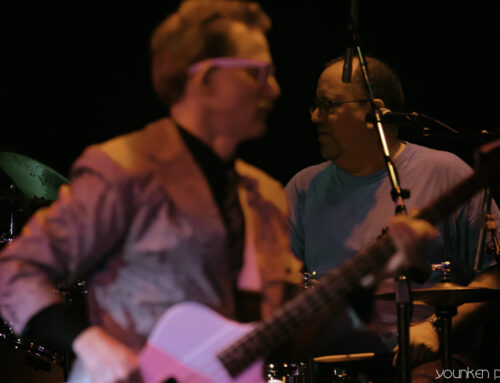Songs I Wish I’d Written: Very Friendly
Others had incorporated noise and environmental sound in music before, particularly avant-garde composers like Lucier and Cage and Riley. And pop artists like the Beatles and Beach Boys incorporated noise as ornamentation in otherwise more traditional songs. But Throbbing Gristle pioneered and, for at least a limited number of people, popularized the idea of noise AS music. What Chuck Berry was to rock and roll, TG were to what became known as industrial music.
If you want to know more about TG, search Google. If you want to know a LOT more about TG, check out Wreckers of Civilisation, the outstanding biography by Simon Ford. For now, though, I ask you to consider this composition of theirs—one hesitates to call it a song, exactly—that I’ve always wished I’d written. It’s among their earliest recordings. It’s entitled “Very Friendly,” and it’s horrifying on several different levels. Put headphones on, turn it up, and close your eyes to secure the maximum impact.
Did you get very far? If not, I don’t blame you. TG clearly didn’t make this to entertain: they made it to provoke. Like I said in my post about “September Gurls,” not everything I wish I’d written is particularly listener-friendly. This is accessible for TG, but it’s quite antagonistic.
Also incredibly compelling.
The Sound and Structure of “Very Friendly”
Let’s consider the music for a moment before turning to the more complicated issue of the song’s subject matter. At 18 minutes, this is an endurance test. A primitive but propulsive two-note bass pulse played by leader Genesis P-Orridge dominates the first 12 minutes. In lieu of traditional percussion, white noise and static run in tandem with the bass, creating an insistent, hypnotic rhythm. That rhythm pauses every few minutes, dissolving into what sound like foghorns and random bass slides. Over this, untrained musician Cosi Fanni Tutti wrests barely recognizable smears of sound from her electric guitar. It’s a bit like krautrock icons Can or Neu without the icy precision.
Noisy and chaotic and utterly without pretense to “accomplished” musicianship, nobody was doing anything like this when TG recorded “Very Friendly” 1976. Even the mighty Pere Ubu, while no strangers to noise, were always a rock and roll band at their core. Throbbing Gristle was something else.
For the last six minutes, the pulse disappears, supplanted by a quiet electronic unease punctuated by stabs of formless electric guitar skronk and hissing synths and tapes. It’s calmer than the 12 minutes of anxious pulsing that came first, but it’s just a different kind of unnerving.
The remaining sonic element is Genesis P-Orridge’s vocal: a mostly affectless spoken narration, punctuated by the occasional shrill syllable or onomatopoeic effects, which are rendered more stark by the contrast between them and the rest of the matter-of-fact delivery. Two stylized phrases are repeated regularly, and become progressively more unpleasant as the piece goes on: a drawled “drinking German wiiiiine,” and the titular phrase, “very friendly.”
The Subject of “Very Friendly,” part 1
The reason these phrases become more disturbing as we go along is the subject of P-Orridge’s narrative: he relates the circumstances of the last murder committed by the U.K.’s “Moors Murderers,” Ian Brady and Myra Hindley. They evoked a revulsion and fascination in the U.K. not dissimilar to that associated with the Manson family in the United States a few years later.
I don’t know about you, but I cannot listen to this detailed, perhaps even gratuitous, description of a premeditated, random, savage, remorseless killing without feeling a kind of creepy voyeuristic guilt. I don’t want to hear about it. It repels me. But then, part of me does want to hear about it at the same time. It’s a natural human reaction: an inability to stop observing the horror as it unfurls.
P-Orridge’s recounting of the murder is, honestly, the only reason to stick with all eighteen minutes of this piece. If you stick with it for four minutes, you’re going to stick with it through the end of the narrative. You have to. The members of TG were fully aware of this dynamic, and here they exploit it.
TG also knew the horror would be underscored by leavening it with a little humor, however black. P-Orridge includes some wry asides about the flooring in Myra Hindley’s mother’s house, and what was playing on the television, and even how Myra Hindley’s family members made allowances for Ian Brady’s “funny habits.” These details add necessary chiaroscuro, but steer well clear of trying make this funny.
The narrative concludes when Hindley’s brother-in-law, David Smith, whom the murderous duo attempted to involve, calls the police from a phone booth the next day to report what he’s seen. At this point that the relentless pulse drops out, and P-Orridge conveys Smith’s fear and uncertainty, stuttering “There’s been a m-m-m-m-murder…” That line echoes repeatedly over that final six minutes of uneasy proto-ambient noise, interspersed with an echo of the titular phrase, “very friendly.”
The Subject of “Very Friendly,” Part 2
Does incorporation into a “pop” song cheapen, perhaps even commodify this murder? Of course it does. And yet…we’re not being entertained here. TG may be fascinated by these events, but they aren’t celebrating them.
If mere titillation were the goal, why repeat “There’s been a m-m-m-murder” for so long at the end of the story? TG emphasize this line because they’re reminding you of what you’ve been listening to. As their attitudinal mentor William S. Burroughs phrased it, they are making you focus on the naked lunch at the end of your fork.
Ultimately, that’s what I admire so much about “Very Friendly.” The impact of this song on my own music is indirect: I’ve incorporated noise often, but never employed noise for noise’s sake…and I’ve never written about murder. But the impulse to provoke, to startle, to jolt? I’m quite familiar with the desire to make someone think.
We can debate how effectively TG provokes you to think, but their intent is clear. And as distasteful as the story is, TG santizes nothing. They leave the horror intact. Contrast that with a song like “Stackerlee,” in which killing isn’t just trivialized, it’s actually celebrated. TG’s presentation of this tale as if it were “just more information,” to adopt a line from the song itself, is a much more honest, even moral approach.
But it remains problematic. In delivering this awful narrative, and then asking you to think about what element it is in human beings that responds to this kind of tale, TG pose an unsettling dilemma. Ultimately, “Very Friendly” concerns not merely the Moors Murderers, but our larger fascination with killers and killing, stretching back to Cain and Abel.
And really, if “Very Friendly” is so sick, why do you think “If it bleeds, it leads” is a maxim in broadcast news? And why do you think the “True Crime” section of your local corporate bookstore is so well stocked? The problem, TG knows, isn’t the people telling the story. The problem is the people who listen to the story, rapt.
The joke, of course, is that the people telling the story and the people listening to the story ultimately are one and the same.
The problem is us.






